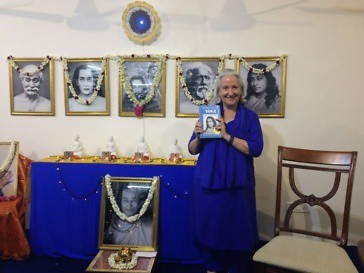We came into the world just weeks apart, Autobiography of a Yogi and I, born together in December 1946. Both of us were riding on waves of human hope: I was part of the “baby boomer” generation that emerged after millions of American servicemen returned from World War II. Hoping to leave the horrors of war behind, the soldiers wanted nothing more than to create a secure, prosperous life for their children.
 And the Autobiography was published at the same time, when people were still reeling from the destruction that had been unleashed during the war. Many had lost faith, and in the war’s aftermath were desperately hoping for answers: Is there any meaning in life? Is it possible for mankind to live in peace? Is there a God? Does He hear our prayers?
And the Autobiography was published at the same time, when people were still reeling from the destruction that had been unleashed during the war. Many had lost faith, and in the war’s aftermath were desperately hoping for answers: Is there any meaning in life? Is it possible for mankind to live in peace? Is there a God? Does He hear our prayers?
Paramhansa Yogananda’s Autobiography of a Yogi and I both turn seventy this year. In the span of our shared lifetime many hopes have been fulfilled, but new challenges have arisen. Nevertheless, we have lived through this time together, and I’d like share with you our journey.
I first saw the Autobiography, with the picture of Yogananda on its cover, when I was about four years old. It was in a magazine advertisement for the book, and though I couldn’t yet read, I remember staring at the photo of his face for a long time. “Is this a man or woman?” I wondered. His face and especially his eyes long remained impressed on my mind.
When I was eighteen, I read A Passage to India by E.M. Forster, which depicts the frustration and anguish of Indians and Westerners trying to understand and befriend each other. When I finished reading the book, I lay on my bed and cried for almost an hour. Though I didn’t understand why at the time, I felt an overwhelming sadness that Easterners and Westerners couldn’t find a way to come together.
Four years later, as a college student in Madison, Wisconsin, I was handed a copy of the Autobiography. As with most important events in my life, it took me a while to recognize the impact and significance that it would have for me over time. On my first attempt to read it, in May 1969, I bogged down: My mind was distracted and preoccupied with upcoming final exams, college graduation, and the question of what next to do with my life.
At the same time, a friend handed me a one-page flyer about Ananda Meditation Retreat in Northern California. It said that Ananda had been founded by a Swami Kriyananda, a direct disciple of Paramhansa Yogananda. “Aha,” I thought as I read the flyer, “this could solve two of my problems.” I could go to Ananda, take time to read the Autobiography, and sort out what I wanted to do next.
After finishing my last final I traveled to California, with a copy of the Autobiography as my only companion, to find the remote meditation retreat I’d read about in the flyer. Shortly after arriving on July 4,1969 (coincidentally the birthday of Ananda Village), I met Swami Kriyananda, who was to be my spiritual teacher, guide, and friend until his passing in 2013.
Coming to Ananda and meeting Kriyananda were, for me, the missing links that forged a living connection with the Autobiography. Through its pages I began to hear an inner voice that was deeply familiar and beloved—a voice that spoke of truths that I remembered and longed to know again.
This voice, rich with wisdom, subtlety, and humor, spoke of the need for uniting East and West, and for knowing God. It whispered in my soul, “If you want to feel my presence more deeply, get to know me in meditation.” And this I did, beginning at that time a lifelong daily practice of meditation. Each time over the years when I’ve reread the Autobiography, this voice is at once familiar and somehow different, revealing ever more of its spiritual wisdom and beauty with each reading.
For years I have used this book as an oracle. Whenever I am faced with a problem in my life, I open the Autobiography three times at random. With amazing accuracy and in direct response to my question, the answer invariably appears in one of the three passages upon which my eyes fall.
Autobiography of a Yogi has been a living reality for me, always beckoning towards the summit where my soul longs to go. Nearly fifty years have passed since my first encounter, and I feel like I’m just beginning to know the book and its author.
And yet my journey doesn’t end there. As my husband and I travel around the world sharing Yogananda’s teachings, we meet literally thousands of people who have received inspiration and hope from this book.
I realize increasingly that we are all on the same journey with the Autobiography, and that the voice that first spoke in my heart so long ago speaks in the hearts of all who read it and want to listen. The book concludes with the sentence, “Lord, Thou hast given this monk a large family.” Yogananda, in turn, has given that family to each of his devoted readers.
In Master’s joy,
Nayaswami Devi
View the Autobiography of a Yogi Spiritual Renewal Week 2016 talk with Nayaswami Jyotish and Nayaswami Devi here.
